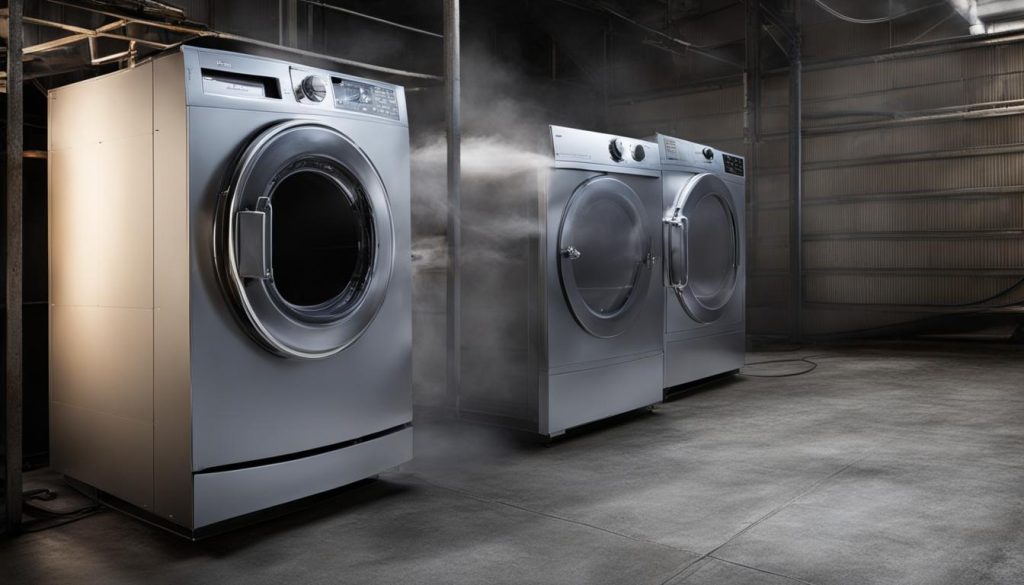If you’ve noticed a burning smell coming from your dryer, you’re not alone. This unpleasant odour can be caused by a variety of issues, ranging from simple fixes to more complex problems.
In this section, we will dive into the potential reasons behind the burning smell in your dryer, from overloaded machines to faulty components. By understanding the common causes of this issue, you can take appropriate action to resolve it and keep your dryer running smoothly.
Key Takeaways:
- Understanding the causes of a burning smell in your dryer is crucial to addressing the issue.
- An overloaded dryer can cause excessive strain on components, leading to overheating and a burning smell.
- Clogged lint traps and blocked dryer vents can restrict airflow and cause the dryer to overheat, resulting in a burning smell.
- Faulty heating elements, worn-out drum rollers or belts, and foreign objects in the dryer can also generate a burning smell.
- Regular maintenance and attention to proper usage guidelines can prevent burning smells from occurring in your dryer.
Overloaded Dryer
An overloaded dryer is a common cause of a burning smell. When you overload your dryer, it puts excessive strain on the motor, heating element, or belt, leading to overheating and a burning smell. To prevent this issue, it is essential to know how to properly load your dryer.
Firstly, make sure to follow the manufacturer’s guidelines for your dryer’s capacity. Overloading your dryer is not only bad for the machine but also your clothes as they may not dry properly and wrinkle. Secondly, try to distribute the weight of the clothes evenly. If you load all heavy items on one side, it can cause the dryer to become unbalanced and lead to additional strain on the machine.
It is recommended to load your dryer by weight rather than by volume. A good rule of thumb is to fill your dryer about three-quarters full for optimal performance. If you notice any resistance or difficulty closing the door, it may be a sign that you have overloaded your dryer.
Table: Recommended Dryer Load Sizes
| Type of Clothing | Weight |
|---|---|
| T-shirts and Underwear | 1-2 pounds |
| Pants and Shirts | 3-5 pounds |
| Towels and Sheets | 6-9 pounds |
By following these guidelines, you can avoid overloading your dryer, prevent overheating, and eliminate those unpleasant burning smells.
Lint buildup in the lint trap
One of the most common reasons for a burning smell in your dryer is lint buildup in the lint trap. When you don’t clean the lint trap regularly, it can restrict airflow and cause the dryer to overheat, leading to a burning smell.
It’s recommended to clean the lint trap after every use, as it not only prevents the smell but also helps your dryer operate more efficiently. Here’s how to clean the lint trap effectively:
- Locate the lint trap. It’s typically located inside the dryer door or on the top of the dryer.
- Slide the lint trap out of its slot.
- Remove the lint from the trap using your fingers or a brush.
- Dispose of the lint in a trash can or compost bin.
- Insert the lint trap back into its slot.
If your lint trap is damaged or doesn’t fit properly, replace it immediately to avoid any future issues. It’s also important to periodically check the vent hose for lint buildup and clear it out as needed.
Blocked Dryer Vent: How to Inspect and Clear Your Dryer Vent
If you notice a burning smell coming from your dryer, one possible cause is a blocked or partially obstructed dryer vent. A blocked vent can cause heat to build up inside the dryer, leading to overheating and potentially a fire hazard. In this section, we will discuss how to inspect and clean your dryer vent to ensure proper airflow.
Signs of a Blocked Dryer Vent
Before inspecting your dryer vent, it’s important to know the signs of a blocked vent. These may include:
- Longer than usual drying times
- A hot or humid laundry room
- An accumulation of lint around the dryer’s lint trap or outside vent
- A burning smell coming from the dryer
If you notice any of these signs, it’s important to inspect your dryer vent.
How to Inspect Your Dryer Vent
To inspect your dryer vent, follow these steps:
- Turn off your dryer and unplug it from the electrical outlet.
- Locate your dryer vent behind the dryer. It should be a short, straight metal or plastic tube leading to the outside of your home.
- Remove the vent from the back of the dryer and the outside vent cover.
- Inspect the vent for any visible blockages, such as lint or debris.
- Use a vacuum attachment or long-handled brush to remove any blockages from the vent.
- Reconnect the vent and outside vent cover, ensuring a secure fit.
If you are unable to inspect or clear your dryer vent yourself, consider hiring a professional technician to do so.
How to Prevent a Blocked Dryer Vent
Regular maintenance can help prevent a blocked dryer vent. Here are some tips:
- Clean the lint trap after every use.
- Check the vent for blockages every six months.
- Avoid overloading the dryer.
- Ensure the dryer vent is properly installed and secured.
By following these tips, you can help ensure your dryer operates safely and efficiently.

Foreign Objects in the Dryer
If you’ve noticed a burning smell coming from your dryer, it’s possible that a foreign object has become lodged in the machine and is causing friction. Items such as coins, pens, or even small articles of clothing can get stuck in the dryer and cause a burning odour. It’s important to take action as soon as possible to avoid any potential damage to the machine or risk of fire.
To check for foreign objects, start by unplugging the dryer and carefully inspecting the drum. Look for any items that may be stuck and gently remove them. Avoid using any sharp tools or excessive force, as this can cause damage to the dryer or create a safety hazard.
If you cannot find the item, it may be lodged in the lint trap or vent. Remove the lint trap and look for any foreign objects caught inside. Similarly, inspect the vent for any blockages and remove any debris that may be obstructing airflow. Follow the manufacturer’s guidelines for cleaning the lint trap and vent, as improper cleaning can also cause a burning smell.
Examples of foreign objects that could be stuck in your dryer:
| Name | Description |
|---|---|
| Coins | Small changes left in pockets can fall out and become lodged in the dryer. |
| Pens | A pen left in a pocket can leak ink and cause a mess in the dryer. |
| Clothing | Small articles of clothing such as socks or underwear can get stuck in the dryer and create friction. |
Once you have removed any foreign objects and cleaned the lint trap and vent, plug the dryer back in and run it for a short cycle to ensure that the burning odour has disappeared. Taking these steps can help prevent damage to the dryer and ensure safe operation.
Electrical Issues
If your dryer is emitting a burning smell, it may be due to an electrical issue. Electrical problems can be hazardous and should be addressed as soon as possible. Here are some potential causes of electrical issues that can lead to a burning smell:
- Faulty wiring
- Short circuit
- Loose connections
- Malfunctioning electrical components
It is crucial to identify and address any electrical issues immediately to prevent potential safety hazards. Do not attempt to repair electrical components unless you are a qualified professional.
If you suspect an electrical issue is the cause of the burning smell, unplug the dryer immediately and contact a professional electrician or dryer repair service for assistance.
Note: Never attempt to repair electrical components unless you are a qualified professional. Safety should always be your top priority when dealing with electrical issues.
Improper Venting in the Dryer
Proper venting is essential to prevent heat buildup and ensure efficient operation of your dryer. Improper venting can lead to poor airflow, causing a burning smell, and increasing the risk of fire.
The vents should be checked regularly, especially if the dryer is used frequently. Ensure that the vent hose is not kinked or damaged and that it is correctly attached to the dryer and vent outlet.
Avoid long vent runs and ensure that any elbows are kept to a minimum to reduce resistance to airflow. A clogged vent may require professional cleaning.
| Signs of improper venting: | Solution: |
|---|---|
| The dryer is taking longer than usual to dry clothes | Check the vent for clogs or restrictions. Clean the lint trap after every use. |
| The dryer is overheating | Check the vent hose for kinks or damage. Ensure that the vent hose is the correct length and properly attached to the dryer and vent outlet. |
| A mouldy smell is coming from the dryer | Check the vent for moisture buildup, which can occur if the vent is clogged or improperly installed. |
If you are unsure how to properly vent your dryer or suspect that improper venting may be causing issues, consult a professional.
Conclusion
Dealing with a burning smell from your dryer can be stressful and overwhelming, but by following the troubleshooting steps outlined in this article, you can quickly identify and address the issue. Remember to regularly clean your lint trap, inspect and clean your dryer vent, and properly load your dryer to prevent future problems.
If you suspect a faulty component, such as the heating element, drum roller or belt, or motor, it is essential to address the issue promptly to prevent further damage to your dryer. You can consult your dryer’s manual for specific instructions on how to troubleshoot and replace these components.
Always prioritize safety when dealing with electrical issues and consider consulting a professional if you are unsure or uncomfortable with making any repairs or replacements yourself. With proper maintenance and usage guidelines, you can keep your dryer operating efficiently and odour-free for years to come.

Written by Max | An appliance repair technician with more than 15 years experience in appliance repair services in Toronto and the GTA.
Disclaimer: This post "Why is my dryer producing a burning smell?" is for information purposes only. If you need specific help, please contact Max Appliance Repair at https://www.maxappliancerepair.ca/contact/.